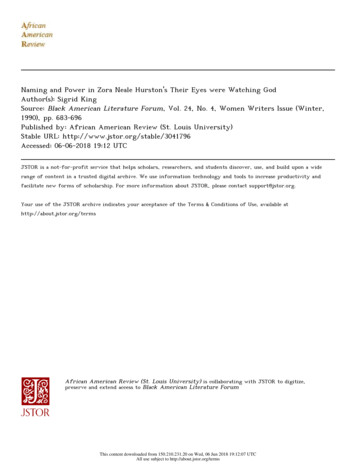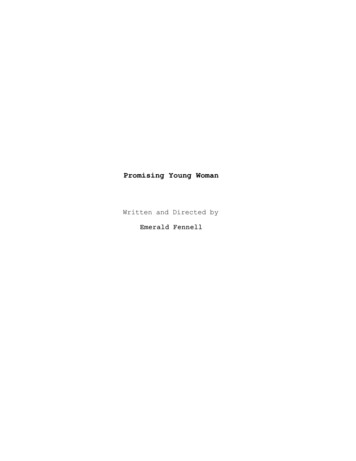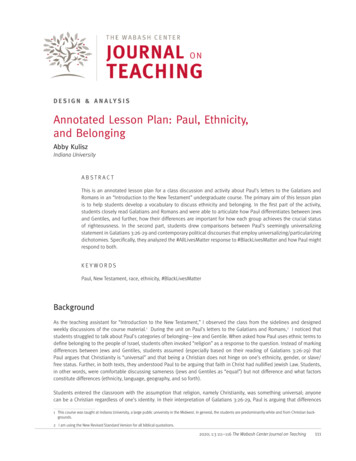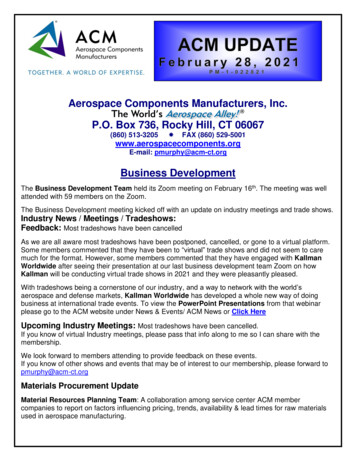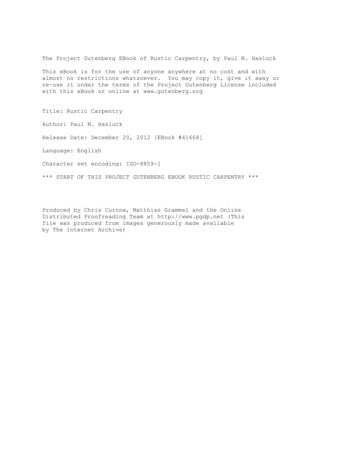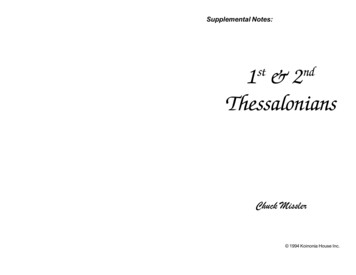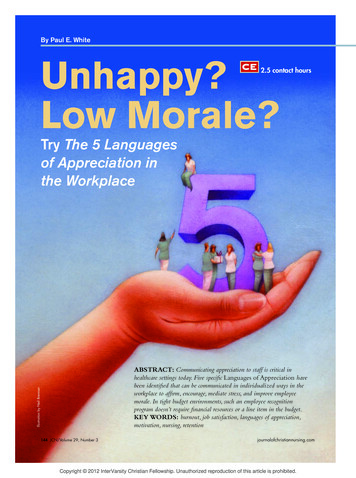
Transcription
By Paul E. WhiteUnhappy?Low Morale?2.5 contact hoursTry The 5 Languagesof Appreciation inthe WorkplaceIllustration by Neil BrennanABSTRACT: Communicating appreciation to staff is critical inhealthcare settings today. Five specific Languages of Appreciation havebeen identified that can be communicated in individualized ways in theworkplace to affirm, encourage, mediate stress, and improve employeemorale. In tight budget environments, such an employee recognitionprogram doesn’t require financial resources or a line item in the budget.KEY WORDS: burnout, job satisfaction, languages of appreciation,motivation, nursing, retention144 JCN/Volume 29, Number 3journalofchristiannursing.comCopyright 2012 InterVarsity Christian Fellowship. Unauthorized reproduction of this article is prohibited.
Susan spoke fondly of Dr. Jones,her employer of the past12 years, who recently retired.She reflected on how Dr. Jonescommunicated his care for her and other staffmembers as he regularly took them out for“team” lunches, asked about their families,and thanked staff after assisting him withprocedures. Susan knew she was an important part of the office team. “No one everwanted to quit,” Susan reminisced. “He wasgreat to work for.”Susan’s experience, a true story,demonstrates the impact of valuingpeople in the work setting. Without asense of being valued by supervisorsand colleagues, workers start to feellike a machine or commodity. StevenCovey, author of the bestselling andstill popular Seven Habits of HighlyEffective People (2004) feels so stronglyabout people’s need for appreciationhe states: “Next to physical survival, thegreatest need of a human being is psychological survival, to be understood,to be affirmed, to be validated, to beappreciated” (p. 241).In the current healthcare environment, nurses and other team members are doing more with less, feelingstressed, and in some cases approachingburnout if not already compassion fatigued. Clinical supervisors and managers across the nation feel frustrated, notknowing how to support and rewardemployees for the hard work theyare doing. Although there are a fewexceptions, virtually every industrysector is struggling financially and asa result, has made staff reductions, reduced expenditures, and slowed downPaul E. White, PhD, is a Christianpsychologist, speaker, consultant, andcoauthor with Gary Chapman of The5 Languages of Appreciation in the Workplace. He has worked with numerousorganizations to help create positiveworkplace environments. Contact Paul at admin@drpaulwhite.com.Paul White is coauthor of The 5 Languages of Appreciationin the Workplace and the Motivating by Appreciation Inventory discussed in this article.Supplemental digital content is available for this article. DirectURL citations appear in the printed text and are provided inthe HTML and PDF versions of this article on the journal’sWeb site , one person can significantly affect theclimate of his or her work environment.raises and bonuses—typical ways usedto value employees. Supervisors feelthey don’t have many options whentrying to reward employees.In these difficult economic timesa common issue raised when talkingabout communicating appreciationis: “Shouldn’t people just be thankfulthey have a job? Why should we focusall of this time and energy on makingemployees feel appreciated? They getpaid, don’t they? Isn’t that enough?”Most agree that people shouldbe thankful for the opportunity towork. However, this does not meanwe shouldn’t be kind and encouraging, communicating our appreciationto colleagues and managers. Scripturespecifically instructs Christians toappreciate and build others up (i.e.,1 Corinthians 13; Ephesians 4:29;Colossians 3:12-13; 1 Thessalonians5:11). Furthermore, Christ-followersare called to be an example to thosewith whom we work, working ina way that honors God and others(Matthew 5:13-16; Ephesians 6:7; 1Peter 2:12).THE APPRECIATION GAPUnfortunately, there is a huge chasmbetween management and employees’ perceptions of appreciation in theworkplace. In Gallup Poll and othersurveys, 65% of workers have reportedreceiving no recognition or appreciation at work in the past 12 months(Rath & Clifton, 2004). For employeeswho quit their jobs, 79% report a lackof appreciation as one of the majorreasons for leaving (Branham, 2005).In contrast, 78% of human resourceexecutives indicate the key to keepingemployees engaged and motivated isby showing them the company caresabout their well-being (Harvard Business Review Analytic Services, 2011).Interestingly, although 80% of largecompanies, including hospitals, haveemployee recognition programs in place,only 31% of employees in these compa-nies report feeling recognized for doinggood quality work (Globoforce, 2011).This baffles managers who often ask,“How can staff not feel appreciated? Itell them I appreciate them all the time.What do they want?”Organizational researchers havefound that nonfinancial factors aresignificant for improving employeemorale, motivation, and engagementwith work. In fact, being treated withrespect is the most important factordesired by employees (Mercer, 2011).Unfortunately, researchers also arefinding that the level of employeeengagement—commitment and sense ofbeing valued—is actually declining, with70% of employees nationally reportingeither total disengagement or marginalengagement in their work, in spite ofthe large amount of resources beingspent in this area (Blessing/White, 2011).Nurses and other healthcare professionals are familiar with appreciationand recognition problems. Job dissatisfaction and high turnover are welldocumented in nursing (Hayes et al.,in press). Job satisfaction is a strongpredictor of nurses’ intent to staywith a current employer (Coomber &Barribal, 2007; Fraser, 2011). Burnout, which impacts job satisfactionand turnover, continues to be of highconcern in nursing (Fraser; Poncet etal., 2007).Ignoring morale and job satisfactioncan be costly, especially when it meansrecruiting and orienting new employees. Retaining quality, experiencednurses is critical in today’s healthcareclimate. Some hospitals have had toreduce the number of nurses and otheremployees and postpone raises andfinancial compensation, even thoughdemands on employees are greaterthan ever. These factors can lead todiscouragement and burnout—whichoccurs more rapidly when employeesdo not feel appreciated or emotionallysupported. Julia Balzer Riley, editorof Communication in Nursing (2011)JCN/July-September 2012 145Copyright 2012 InterVarsity Christian Fellowship. Unauthorized reproduction of this article is prohibited.
one wants to be part of a program thatrequires others to show “canned” appreciation. People want appreciation tobe personal and genuine, not contrived.Trying a general “just say thanks”campaign across the company will notFEELING APPRECIATED IShave much impact. In fact, this typeof approach can backfire and create aCRITICALEach of us wants to know that whatnegative reaction from employees.we are doing matters, that we matter.Buckingham and Clifton (2001)Without a sense of being valued bystate in their bestseller, Now, Discoverothers, employees start to feel theyYour Strengths: “To excel as a manager,are being used like a commodity, notto turn your people’s talents intoviewed as a person. If no one notices aproductive, powerful strengths, requiresteam member’s commitment to doingan additional all-important ingredient.People assume thethe job well, motivation diminishes.Lacking this you will never reachWhen employees do not feel valued, way to help employees excellence. The all-important ingredithe results are predictable. They will:ent is individualization” (p. 171). Thisfeel appreciated iswas demonstrated in the opening example. Susan appreciated her employer experience a lack of connectednessprimarilyverbal.talking with her about her family; shewith the mission of the organizafelt respected when thanked individution; performance declines.ally. Another nurse reported that when become discouraged; willingness tostaff went out for lunch together shepersevere through difficulties willfelt valued as a team member.diminish.about communicating appreciation2. Appreciation needs to be commu complain about their work, colis that it doesn’t require financial renicatedusing the recipient’s preferredleagues, and supervisor.sources or a budget!appreciation language. One challenge is dislike coming to work; attendancemay become inconsistent.to know what most effectively commuEFFECTIVELY COMMUNI consider leaving the organizationnicates appreciation to each memberCATING APPRECIATIONand start to search for other emof a work team. Five basic languagesThere are five key componentsployment opportunities.of appreciation have been identifiedfor employees to think and feel theywhich can be communicated in theare appreciated. Appreciation must beMany people assume the way toworkplace (Chapman & White, 2011):communicated:help employees feel appreciated is priWords of Affirmation, Quality Time, Actsmarily verbal. The truth is some of usof Service, Tangible Gifts, and Appropriate Individually and personally (ratherdon’t value being told we are appreciPhysical Touch (Table 1).than globally and to the group).ated. Some people don’t trust verbalFor example, some people value In the “language of appreciation”praise thinking, “Words are cheap.”being told specifically what they arethat communicates best to theThey may come from backgroundsdoing well and how they are helprecipient.where whenever they were praised,ing patients and the team (Words of Using the specific actions that arethey were being “set up” for being usedimpactful and valued by the recipient. Affirmation). Others feel apprecior manipulated. As a result, their defens- Regularly (versus once a year at aated when coworkers and supervisorses are on high alert when a colleaguespend time with them individually,performance review).or supervisor gives them a compliment. In a way that is perceived as genuine actively listening to them (QualityTherefore, it is important to underTime). To receive help in getting a taskand authentic.stand that communicating appreciationdone can be especially encouraging tois not the same as giving a complimentsome (Acts of Service). There are teamHow do these factors play out in aor writing someone a thank-you note. work setting?members who feel appreciated whenFortunately, there are effectiveyou bring them a little something spe1. Effective recognition andmethods to communicate appreciation appreciation must be individualizedcial, like their favorite cup of Starbucksand encouragement to coworkers and and delivered personally. Researcherscoffee (Tangible Gifts). A “high five”subordinates. Such methods incoror pat on the back for a job well donehave found that attempts to commuporate the different ways individualsmotivates other team members (Apnicate appreciation globally across anreceive the messages sent. A great thing organization are not very effective. No propriate Physical Touch).emphasizes, “In a climate of professional and personal change comingat an unprecedented rate, rewardingcolleagues with praise or by othermethods becomes important” (p. 157).146 JCN/Volume 29, Number 3journalofchristiannursing.comCopyright 2012 InterVarsity Christian Fellowship. Unauthorized reproduction of this article is prohibited.
From a biblical perspective, Christfollowers can readily appreciate thelanguages of appreciation. Christians areto affirm others (Proverbs 10:21, 12:18),give encouragement (Hebrews 10:25),actively serve others (Matthew 20:26-28;Galatians 6:10), generously share ourbelongings (Acts 2:44-45; 1 Timothy6:18), and share culturally appropriateacts of affection (Romans 16:16). A moreextensive Bible study for the 5 Languagesof Appreciation at Work can be foundonline as supplement digital content athttp://links.lww.com/NCF-JCN/A13.3. A challenge to effective appreciation is we tend to communicate to othersin ways that are most meaningful tous. It is a natural tendency to speakin our preferred language. However,our colleagues often value differenttypes of appreciation. This can leadto a message of appreciation “missingthe mark.” Missing the mark is whymany employees are not encouragedwhen they receive an award as part ofthe company’s recognition plan—theexperience doesn’t speak in their preferred language of appreciation. In fact,one worker who did not like being inthe limelight said, “You can give mean award, but before I go up and getit you’ll have to shoot me.” It is criticalto show appreciation to coworkers inthe appreciation language they value.Table 1: Five Basic Languagesof Appreciation in the Workplace(Chapman & White, 2011)Words of Affirmation—using words tocommunicate a positive message to anotherpersonQuality Time—giving someone your undivided attentionActs of Service—providing assistance toone’s colleaguesTangible Gifts—giving a gift to someonewho appreciates and values that specificgiftAppropriate Physical Touch—affirmingsomeone through a physical gesture (pat onthe back, high five, fist bump, handshake)journalofchristiannursing.comIt is difficult to infer anotherperson’s preferred appreciation language simply through observation.For most of us there are too manyrelationships to keep track of everyone’s preferences and there usuallyisn’t enough information to makean accurate assessment of all coworkers. This is especially true in settingswith rotating shifts and numerousstaff members reporting to differentimmediate supervisors such as chargenurses, or working in different areas.Since each individual receives andvalues appreciation differently, supervisors and colleagues need to understand the appreciation language of therecipient to communicate appreciationeffectively. To simplify this process, wedeveloped the Motivating by AppreciationInventory (White & Chapman, 2011)to assess individual employees’ languageof appreciation. Managers can assesstheir employees’ languages of appreciation by giving them this simple onlineinventory of 30 questions that takesless than 15 minutes to complete.Responses indicate which languagethe employee prefers primarily andsecondarily to receive appreciativecommunication. With permission fromstaff, managers can post the results forall staff to share with the entire team. Afree group profile template (Figure 1)is available from Appreciation at Work(see Web Resources).4. Acts of appreciation need to beviewed as valuable by the recipient.Even if appreciation is communicatedin the right language, if the action isnot valued by the recipient, it has littleimpact. For example, Quality Timemeans different things to differentpeople. It can mean spending individual time talking, going to lunch,or getting together after work. Thechallenge is knowing what actionseffectively communicate appreciation.The Motivating by Appreciation Inventoryassists in determining which languageand actions are most meaningful foremployees or coworkers (White &Chapman, 2011).5. For appreciation to be effectiveand believable, it must be communicatedregularly. Receiving positive feedbacksolely at performance reviews doesnot lead employees to believe they aretruly valued. Whatever praise they mayreceive is discounted by the fact thatthey only hear it once or twice a yearwhen it is prescribed by the structureof the meeting.How often should appreciation begiven? Daily? Weekly? Monthly? Theanswer is it depends on various factorssuch as the workplace environment,the personality of the individual, therelationship between the supervisorand supervisee, and the professionalexperience of the team member. A seasoned confident nurse who has a goodrelationship with the manager probablyneeds appreciation communicated lessfrequently than a new graduate who is“learning the ropes.” In highly stressfulenvironments, small acts of encouragement may be needed daily while communication every couple of weeks maybe sufficient in other settings. Regardless of the actual rate of communication, more is generally better than less. Ifin doubt, it won’t hurt to do somethingto ensure a colleague knows you valueher or him and the contributions he orshe makes.6. Appreciation needs to be communicated in a way that is perceived asauthentic by the recipient. Workers areskeptical of programs implementedfrom the top down where supervisorsare given standardized instruction to“communicate appreciation for eachteam member at least once a week.” Weall want to know we are valued but wewant appreciation to be authentic, notcontrived. Ultimately, it is each individual’s responsibility to ensure honest,heartfelt communication. We also knowthat if an organization-wide implementation of “showing appreciation”is mandated, the results can be terrible.Why? Because the mandate immediately undermines the perceivedauthenticity of any appreciation communicated, even if it is genuine andheartfelt.Nurses at any level within an organization can communicate appreciation to colleagues. Each person has theJCN/July-September 2012 147Copyright 2012 InterVarsity Christian Fellowship. Unauthorized reproduction of this article is prohibited.
Case Study in Appreciation:Jennifer, a supervisor for three medical/surgical hospitalfloors, observed the stress level rise steadily related to tighterstaffing to reduce costs. In addition, the patient care units weremoving to electronic medical records. Jennifer had observed anoticeable decline in staff morale; team members were tenseand irritable and there seemed to be more complaining.One day Jennifer overheard a staff nurse lament, “Do this.Do that. I just move through the day with no please, no thankyou. You never hear anything positive.” Others nodded theirheads in agreement. Another nurse commented, “I feel likechucking this job and working somewhere else.”Unfortunately, Jennifer agreed. The constant demands seemedto be growing with little positive communication coming from administration, physicians, the patients, or patients’ families. Signsof stress were showing up in complaining, returning late frombreaks, and “bending” rules.Determined something had to be done, Jennifer decided towork with the unit nurse managers and charge nurses towardchange. After doing some research she discovered and read The5 Languages of Appreciation in the Workplace (Chapman &White, 2011). Jennifer realized the behaviors she was observingwere classic examples of staff not feeling valued or appreciated.After reading the book and taking the Motivating By Appreciation Inventory (White & Chapman, 2011), Jennifer decided toapproach her team. She shared her observations, which theyagreed with unanimously. She asked if they would be willing togo through a process to help find ways to support and encourageone another, with the goal of eventually using the resources withall team members.“As long as it isn’t going to take a lot of extra time, I’m up forit,” Chad, one of the nurse managers said.“I’m ok with it if it isn’t one of those ‘write 5 thank you notesa week’ projects that human resources tries to have us do everyyear,” chimed in Maria, another manager.Jennifer replied, “We will do this as part of our regular teammeeting so it won’t take any additional time, and we won’t do itevery week. If you want to read the book, fine. If you just want totake the inventory, that’s okay, too. It’s online and you can do itwhenever it works for you. And we’ll make sure the action stepsare ones that fit what we really need.”Over the next 9 weeks Jennifer and her team went throughan appreciation training process, which included watching10-minute instructional videos every few weeks, discussing thematerial, and developing action steps after each session. Eachweek, they received an e-mail from Jennifer, which provided bothencouragement and instruction in how to apply the concepts towork relationships. They talked about the “weirdness factor” oftrying to encourage one another while everyone knew they wereworking on the issue together; and how to make sure whateverappreciation was shared was perceived as authentic and notcontrived.One of the key pieces of change was discovering theirpreferred languages of appreciation, along with specific actionsthat would be meaningful to each colleague. For example, Chaddidn’t value verbal praise. But if someone spent some time hanging out, watching a game after work with him or talked withhim about college sports, he felt more connected. Conversely,Shakyra, a charge nurse, valued focused attention. She loved totalk and have others listen. If a colleague would ask her abouther kids and listen to a story, she felt supported. So althoughboth Chad and Shakyra’s primary language of appreciation wasQuality Time, the practical outworking looked quite different.148 JCN/Volume 29, Number 3Jennifer began to notice the team’s attitudes improve. Themanagers and charge nurses were more positive in their interactions together, joked more, and seemed more energized. This wascorroborated by Chad, who said, “I was pretty skeptical about thisappreciation thing. It seemed too touchy-feely. But I have to tell you,it’s nice to hear a compliment when you have done something well.”Over the following weeks, some of the managers and chargenurses decided to implement the Appreciation at Work trainingwith their teams. Chad observed Nancy, a nurse on the unit, staylate on a busy Friday, cheerfully answering patient calls. He hadlearned Nancy primarily responds to Words of Affirmation sohe encouraged her by saying, “I really appreciate your cheerfulresponses to the patients’ calls. You help us all stay positive understress.” He added a quick pat on the back knowing Nancy’s secondary language of appreciation is Appropriate Physical Touch.Shakyra discovered that Jim, a staff nurse, enjoys Acts ofService to show him he is appreciated. Giving him help withpatient care or making sure he has taken his break communicateto Jim he is valued. For Susan, the unit secretary, checking in withher periodically during the shift to ask if she needs help communicates she is a valued team member. To Jim and Susan, whenpeople are willing to help them they feel significant.Amy, a staff nurse, appreciates Tangible Gifts. She enjoys the“theme dinner” nights in the hospital cafeteria, which aren’t a bigdeal, but are fun and make her feel special. She eats there withher nurse manager Maria, whose primary language of appreciation also is Tangible Gifts. Maria enjoys the crafts and bakedgoods staff members bring for holidays and birthdays as thesemake her feel she is appreciated and that coworkers value eachother. The group chart of the staff’s appreciation languages Mariaput up in her office helps her remember everyone’s primary andsecondary appreciation languages.As a result of these efforts, the morale in the medical/surgicalarea gradually improved. There were still high-stress days butoverall the atmosphere and interactions were less edgy. “Oooh,thanks; I feel so appreciated now!” became one of the standardjokes on the floor, giving staff an opportunity to laugh together.journalofchristiannursing.comCopyright 2012 InterVarsity Christian Fellowship. Unauthorized reproduction of this article is prohibited.
ability to positively influence thosewith whom she or he works; it is nota responsibility relegated only to supervisors or managers. In fact, in manysettings front-line staffs have startedthe process of consistently communicating appreciation to peers. As a resultof the changes observed, their supervisors have implemented appreciationconcepts organization-wide.Of significance, just one personcan positively impact the work climate. Anne, a nurse at an area hospital, reports she can always tell whichcharge nurse is working on a particular unit by the body language of thenurses she sees when she gets off theelevator. Are they warm and friendly,or stiff and cold? Anne notices shefinds herself hurrying to get her workfinished when she feels the “cold”environment around her. She hopesthe “warm, friendly” charge nurse isleading when she works on that unit.The environment reflects the friendlycharge nurse’s positive attitude and encouraging words, which helps unit staffwant to perform with excellence. Attitudes are infectious. This charge nursecommunicates to coworkers they areappreciated and necessary. Review theCase Study in Appreciation for additionalinsights on how languages of appreciation can be implemented at work.Figure 1. Group profile template.CONCLUSIONThe stress level in most healthcaresettings is high, creating demandingwork environments. Long exposure tostress eventually leads to burnout, wherepeople either become ineffective in theirwork (just “going through the motions”)or quit their jobs. But the stress of theworkplace can be mediated when teammembers feel genuinely valued and appreciated for their contributions. Whenemployees enjoy their work more, communication in the workplace becomesmore positive.Although attempts to encourage andsupport staff through employee recognition programs have been ineffective, corefactors have been identified that help stafffeel valued and appreciated. To be communicated effectively, appreciation shouldbe expressed personally and individually,in the language and actions valued by therecipient, consistently over time, and ina manner that is perceived as authenticby the recipient. As a result, supervisorsand managers don’t have to “shoot inthe dark,” trying to guess what will beeffective in encouraging individual teammembers. Understanding and utilizingthe Languages of Appreciation can allowsupervisors, employees, and coworkers toimplement specific actions of appreciation in ways that will “hit the mark” andeffectively encourage others.Web Resources Appreciation at Work—http://www.appreciationatwork.com/ Managing by m/ Globoforce—http://www.globoforce.com/ How Full Is Your Bucket?—http://www.bucketbook.comBlessing/White (2011). Employee engagement report:2011. Retrieved from ingWhite 2011 EE Report.pdfBranham, L. (2005). The 7 hidden reasons employees leave:How to recognize the subtle signs and act before it’s too late.New York, NY: AMACOM.Buckingham, M., & Clifton, D. O. (2001). Now, discoveryour strengths. New York, NY: Free Press.Chapman, G., & White, P. (2011). The 5 languages ofappreciation in the workplace. Chicago, IL: Northfield.Coomber, B., & Barribal, K. L. (2007). Impact of jobsatisfaction components on intent to leave and turnoverfor hospital-based nurses: A review of the researchliterature. International Journal of Nursing Studies, 44(2),297–314.Covey, S. R. (2004). The 7 habits of highly effective people(rev. ed.). New York, NY: Free Press.Fraser, S. (2011). Influencing outlook: The importanceof nursing staff satisfaction. Nursing Management, 41(9),12–16.Globoforce. (2011). SHRM survey findings: Employee recognition programs. Retrieved from http://go.globoforce.com/5-KEY-TRENDS.html?kk 1bac917d-a868-4038-a28e-8a89344601f2&kt 9385968624Harvard Business Review Analytic Services. (2011).Who will build your future? The new employeerelationship. Retrieved from shq.businesswire.com/files/white demployersMK-2849.pdfHayes, L., O’Brien-Pallas, L., Duffield, C., Shamian, J.,Buchan, J., Hughes, F., Spence-Laschinger, H. K., North,N. (in press). Nurse turnover: A literature review—anupdate. International Journal of Nursing Studies. Retrievedfrom 0020748911003798Mercer. (2011). What’s working: Inside employees’minds. Retrieved from er-pkg/download US.htmlPoncet, M. C., Toullic, P., Papazian, L., Kentish-Barnes,N., Timsit, J., Pochard, F., ., Azoulay, E. (2007). Burnoutsyndrome in critical care nursing staff. American Journalof Respiratory and Critical Care Medicine, 175(7), 698–704.Rath, T., & Clifton, D. O. (2004). How full is your bucket?New York, NY: Gallup.Riley, J. B. (2011). Communication in nursing. (7th ed.). St.Louis, MO: Mosby.White, P., & Chapman, G. (2011). Motivating by appreciation inventory. Wichita, KS: Family Business y-September 2012 149Copyright 2012 InterVarsity Christian Fellowship. Unauthorized reproduction of this article is prohibited.
coauthor with Gary Chapman of The 5 Languages of Appreciation in the Work-place. He has worked with numerous organizations to help create positive workplace environments. Contact Paul at admin@ drpaulwhite.com. Paul White is coauthor of The 5 Languages of Appreciation i

